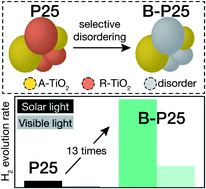Blue ordered/disordered Janus-type TiO2 nanoparticles for enhanced photocatalytic hydrogen generation†
Abstract
Photochemical hydrogen generation from water is a promising solution to concurrently tackle energy and environmental problems. However, the solar-to-hydrogen conversion efficiencies of most photocatalysts are still unsatisfactory due to two major limiting factors: the non-ideal band structure of photocatalysts and the fast recombination of photo-generated charge carriers. Herein, we report a Janus-type TiO2 heterojunction consisting of ordered blue-anatase and disordered black-rutile phases fabricated by the magnesiothermic reduction process. In this process, the surface enthalpy difference of rutile and anatase phases in P25-TiO2 allows the phase-selective reduction to afford novel blue ordered/disordered Janus heterostructure. The joint effect of the improved light absorption and charge separation by the disordered black-rutile phase and the high catalytic activity of the ordered blue-anatase phase, as well as the morphological advantage over order@disorder core–shell structures, significantly enhances the photocatalytic hydrogen production rate to 1.56 mmol h−1 g−1 (11.53 mmol h−1 g−1 with ∼1 wt% Pt), which delivers 13-fold enhancement compared to pristine P25-TiO2.



 Please wait while we load your content...
Please wait while we load your content...